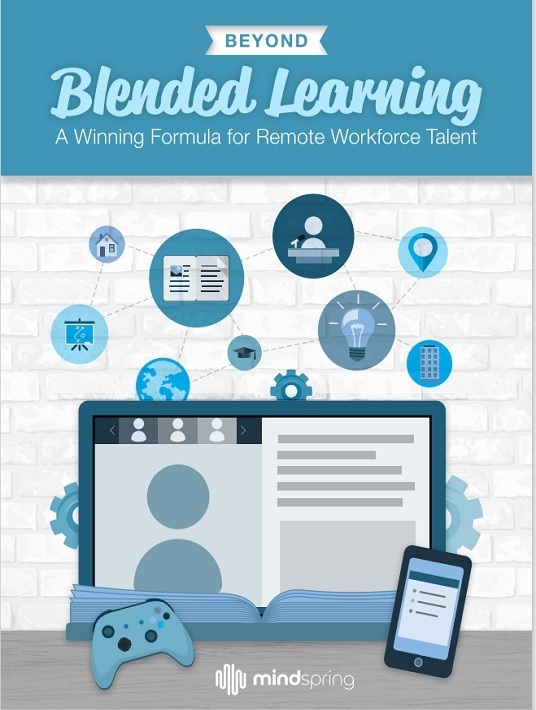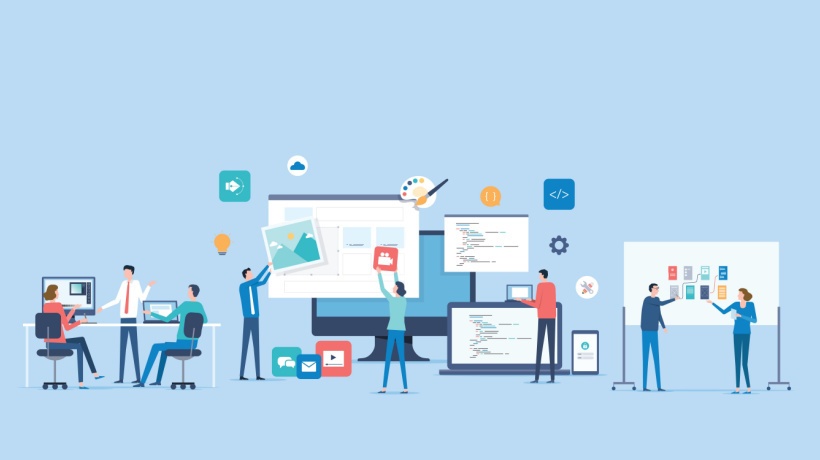Tips To Pinpoint Your Organizational Needs
This article is part of a series exploring the concept of blended learning for remote and on-site workers. What you are about to read is a fable. The company, AshCom, is fictional but the learning challenges faced by Kathryn, AshCom’s CLO, and her team are real and commonly shared by learning teams in large organizations. It is our hope that you will be able to connect with the characters, their challenges, and the solutions they discover. We also invite you to read the first eBook in the series.

AshCom Learning Team's Lattes
Stirring spoons clinked the edges of china cups, blending the steamed milk with rich, dark coffee. Some added sweet caramel, some vanilla. The lattes served to the AshCom learning team were a delicious ending to a wonderful meal and the perfect boost to help tackle the evening’s agenda ahead.
Kathryn, the Chief Learning Officer at AshCom, began the after-dinner session of her learning team’s overnight retreat by saying, “We are here because we have two challenges. We face a growing skills gap in our manufacturing company as more people retire and we find it more challenging to recruit new people to work as technicians. Global competition means we need to find more efficiencies. We need to find a way to increase our production lines while also lowering expenses. This includes learning. And on machines that get more technical as we move forward.”
Striking A Balance
Kathryn let this sink in for a moment. “In other words, we have to find a way to increase learning at a higher level of tech while simultaneously finding methods of doing it faster.”
Heads nodded. Her team was already familiar with this challenge.
“The second problem,” said Kathryn, “is that human resources are asking what learning might look like if they allowed more employees to have flexible schedules or even work completely remotely.”
Again, heads nodded.
Kathryn continued, “I called this overnight brainstorming session to learn from Darryl and Rebecca from Inno-Versity. Our topic is blended learning. Here’s the strange part…”
No one there knew what she was going to say next. Darryl, one of the members of Kathryn’s learning team, shifted uncomfortably in his seat.
“Darryl has been thinking about these two problems, remote and the skills gap,” continued Kathryn. “Let me tell you about his journey.”
Darryl stopped fidgeting.
“At first,” said Kathryn, “Darryl told me that blended learning might be the solution to both challenges. I asked him to dig into it and let me know what he learned. He came back with more questions than answers. At first, he said his research didn’t provide him with a solid definition of blended learning.”
“And then I told you that blended learning might not even be a useful concept anymore,” interrupted Darryl.
Everyone chuckled.
Is Blended Learning Best For Your Organizational Needs?
Michael, a retired academic who served on Kathryn’s team, took this moment to tease Darryl. “Wait a minute, isn’t Darryl leading this discussion tonight and tomorrow? And he doesn’t know what blended learning is and if even he did, he doesn’t think it is worth our time?”
Now everyone laughed out loud.
“Let me tell you the rest of the story,” said Kathryn to Michael. “Darryl and Rebecca from Inno-Versity have spent time thinking about this. When I asked Darryl to give me an update, I think he had in mind setting up a meeting with Rebecca, me, and himself.
“When I heard his summary,” continued Kathryn, “I decided we needed to think through this together. It has been a while since we’ve gotten away from the office and the Ash family had an opening at their cottage. So, I took it. We will spend the next hour or so learning what Darryl and Rebecca have been talking about. We will continue in the morning and go as long as we need to tomorrow afternoon. We have great food, a beautiful location, and plenty of refreshments, so all I ask is that you settle in and that we do something thinking together.”
Turning to Darryl and Rebecca, Kathryn said, “The floor is yours.”
Darryl remained seated, cleared his throat, and said, “Kathryn is right. I thought I had the solution to the skills gap and remote work. Then I wasn’t sure. Then I was sure I didn’t. Then I met with Rebecca, and the skies cleared.”
Rebecca smiled broadly.
“I, or I suppose more accurately, Rebecca and I don’t think blended or non-blended learning matters at the beginning stages of trying to resolve a learning challenge I think we are past that in our discipline. We don’t start out trying to make a blended learning experience.”
Where To Begin?
Maggie, who had been with AshCom for more than 20 years, asked, “So if we don’t know whether a course will be blended or not, how do we know where to begin in our design?”
Amy, a consultant who worked with a lot of large companies nationally, responded, “I’ve seen AshCom make a lot of blended learning experiences in the years I’ve been around. Was the concept bad? Did we point at the wrong thing?”
Rebecca decided to chime in. “I don’t think that’s what Darryl and I are trying to say. The concept of blended is a leftover from a time when all there was available was instructor-led learning. It might have been one-on-one with an experienced person teaching an inexperienced person. Technology like film was the first real opportunity to add something to more traditional learning. Some of that was decades ago. Now we have dozens of modalities to choose from.”
“Sounds like the definition,” said Maggie, “should be ‘blended learning is more than one learning modality.’ Simple.” Maggie smiled.
“Let’s come back to that,” said Darryl. “What I really want to walk through is something Rebecca came up with.”
Darryl walked to the whiteboard that Kathryn brought to the cottage. He wrote “N1+N2+T+D=M.”
“That clears it up,” said Michael. “Anyone else want a gin and tonic?” He did not intend this quite the way it sounded. “Sorry Darryl,” said Michael. “Please continue.”
“Thanks,” said Darryl. “Your apology should be accompanied by a G&T when we are done.” Michael nodded and smiled.
“Let me fill it in a little,” Darryl continued, as he wrote on the board.
Darryl gave everyone a few moments to digest.
“I started with the assumption that blended learning was the solution,” said Darryl.
Defining Blended Learning
“Maggie was close to the right definition. Blended learning is simply delivering a learning experience using more than one modality. But we will only know if that is the right thing to do at end of this formula. We shouldn’t start with the goal of blended learning. It is a result, not an objective. It comes at the end, not at the beginning.”
Kathryn took this moment to clarify something. “We aren’t going to talk through this formula tonight. I only wanted Darryl and Rebecca to introduce it and talk through the first two parts: N1 and N2–the needs of AshCom and the needs of the learners. Tomorrow, we will get into the tools available to us and the learning science.”
“I think the skills gap and the request for remote learning options are connected,” said Darryl, “and at the end of this session, I hope you will too.”
Rebecca said, “Let’s start with the needs of the organization. What does AshCom need right now?”
Alishia, the youngest member of the learning team, replied, “We need to fill the skills gap and we need to know what it would look like for more people to have the option to work remotely which means their learning experiences might need to be delivered remotely.”
“Those might be the objectives,” said Rebecca, “but I don’t think they are the core needs of AshCom. Does anyone else want to take a shot at it?”
The Skills Gap
After a few moments, Martina, who had been silent so far, said “The skills gap actually is the need. Since this first came up, I talked to some friends in human resources. They told me that in the last three years, we’ve lost a huge number of people to retirement. They are happy for those people, but from their perspective, every person who retires represents skills and knowledge leaving.
Rebecca responded, “So the first need of AshCom is to fill the shoes of those who are retiring.” She moved to the whiteboard and next to N1 wrote “Retirements.”
“I think so,” said Martina, “but that’s not the end of it. It seems like fewer young people want to work in manufacturing. Those that are open to work here don’t seem to have the skills necessary.”
“Ok,” said Rebecca. “That’s two,” as she wrote “Recruitment” on the whiteboard. “Anything else?”
Alishia responded before Martina could gather her thoughts. “It is something Kathryn already said. I’ve only been here a couple of years and even I’ve seen automation increase. I know this makes us more efficient and some of this technology is incredible. But working on those lines means a lot more learning is needed if the tools are going to run at their peak productivity.”
“Technical skills,” said Rebecca as she wrote it on the whiteboard. “Anyone else?”
“We have to do all these things faster and with less downtime for the machines,” said Kathryn “When I met with our CHRO Laszlo, he said we need to reduce the time it takes to teach people how to operate these machines. They need less time away from the production floor. Oh, we need to find a way to reduce the time the machines are down so that people can learn on them.”
“So do more with less,” replied Rebecca, adding the word “Faster” on the board. “Does that cover it? Does anyone know the why? Why do we need to do all these things?”
Global Competition
Amy answered quickly, “Global competition,” and noted that every manufacturer she worked with faces this same dynamic. “Everyone is in the same boat. We are no longer competing
with the companies like us in a fifty-mile radius. We compete with everyone who does what we do, no matter where they are.”
Rebecca paused for a few moments. “Amy, you are saying that the core need here is the long-term viability of AshCom? Am I hearing that right?”
“Look,” said Amy, “I’m not trying to be overly dramatic. But if AshCom can’t attract great talent and give them the learning experiences they need to operate complex machines and find the most efficient way to do that, our company is facing a serious threat to its longevity.”
“And that,” said Kathryn, “is exactly what Laszlo told me.”
“So that goes at the top of the N1 list,” said Rebecca as she wrote “Long Term Survival” at the top. “This has to be our top priority because nothing else matters much if the company doesn’t survive.”
No one spoke for nearly 30 seconds. Adeena broke the silence. “Kathryn, since you first brought the challenges of remote learning and the skills gap to us, I’ve done some thinking. But I never put them in this context. This is a bit unnerving.”
Darryl hadn’t said anything for several minutes. “I agree. Once I started thinking about AshCom’s needs, I saw that they went far beyond just the latest challenges. Whether they were blended or not suddenly seemed…unimportant.”
“And by the way,” continued Darryl, “this is why I think the skills gap is related to the growing requests we are getting for remote work options and more flexible schedules.”
“I see it,” said Amy. “AshCom is not the only company facing a growing chorus of people asking to work remotely. At its core, it is also about the long-term viability of AshCom.”
“I get it too,” said Michael. “We need to be able to attract the very best talent. And we need to keep the great people we already have. Without the ability to do either of these, we are right back to a long-term threat situation. I suspect this won’t be that long in the future.”
The Current Threat
Kathryn agreed. “Laszlo isn’t talking about this as a future potential problem. He believes this is a threat right now. As more people see others working remotely, we need to have a plan for this. Our team doesn’t have to answer every question, but we do have to come up with a solution that provides great learning experiences remotely to those who might work that way in the future.”
While she spoke, Rebecca wrote “Attract and Retain Talent” on the whiteboard. When Kathryn finished speaking, Rebecca said, “Note that I didn’t put ‘remote work’ up here. That is not the core need of AshCom. The more essential need is that we need to keep our skilled people and add to them. Attract and retain.”
Kathryn decided this was a good moment to break the tension. “I thought we would get through N1 and N2, the needs of AshCom and the needs of the learners tonight. But I can see this is a good time for us to stop for the night.”
Seeing looks of concern on the faces of her team, she reassured them. “We will talk about the needs of the learners after breakfast tomorrow. But I don’t want to end like this. I’ve seen this team rise to incredible challenges before. I have faith in our skills, our knowledge, and our experience. We will figure this out. This has been a serious discussion, and I know the stakes are high. We will get this figured out with creativity, the application of learning science, and great use of technology.”
The tension broke but did not completely dissipate.
Everyone sat still until Darryl looked at Michael and said, “I’ll take that gin and tonic now.”
Even though the formal session ended, the conversations continued until well after midnight.
Conclusion
Download the eBook Beyond Blended Learning: A Winning Formula For Remote Workforce Talent to discover how AshCom overcomes its L&D challenges using innovative blended learning strategies. Also, join the webinar to uncover valuable insights that will help you improve your L&D planning and learning delivery.









